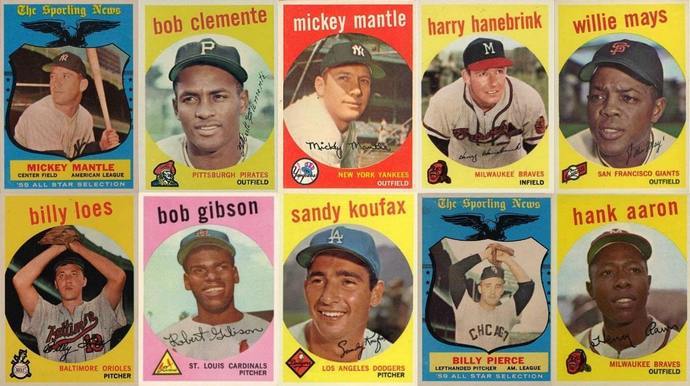Blog

Why are Baby Boomers So Obsessed with Their Collectibles? It's no surprise that Baby Boomers have an affinity for collecting items, from vintage toys to comic books and beyond. But why are Baby Boomers so obsessed with their collectibles? In this blog post, we'll explore the reasons why Baby Boomers have a passion for collecting and the interesting items they seek out. From an emotional connection to a way of staying connected to their past, we'll uncover the many motivations behind Baby Boomer collecting. So read on to find out why Baby Boomers are so passionate about their collections! The historical context of baby boomers and their collectibles The Baby Boomer generation is comprised of those born between the years 1946 and 1964, and they are known to have a special affinity for collecting and preserving items of sentimental value. In the post-World War II years, there was an abundance of goods and services available, which allowed baby boomers to take advantage of the growing economy. This, combined with the desire to relive nostalgic memories, has contributed to the current level of interest in collecting and preserving collectibles among baby boomers. Collecting was not only limited to products of popular culture or trends, but rather included all sorts of items, such as toys, household items, sports memorabilia, vinyl records, and more. Many of these items were considered the “golden age” of collectible pieces and held a lot of sentimental value for many baby boomers. The growing economy and availability of goods provided baby boomers with the opportunity to pursue their interests in collecting. These collections often included items that had been passed down from previous generations, creating a sense of continuity between generations. The nostalgia associated with these items was very powerful and this allowed baby boomers to form a deep connection with them. This deep connection is still prevalent today, as many baby boomers still have strong attachments to their collectibles. It is not uncommon to find older adults who are passionate about collecting and preserving certain items, such as antiques, vintage clothing, coins, stamps, etc. Collecting can be a way for baby boomers to relive the past and preserve memories that would otherwise be forgotten. The psychological reasons behind the obsession Baby boomers are often drawn to collecting as a way to maintain a sense of connection with their past. As the oldest living generation, many baby boomers grew up in an era of rapid social change, and their collectibles provide a tangible reminder of a simpler, more familiar time. For many, their collections are symbols of nostalgia, comfort, and even a sense of security. Beyond nostalgia, many baby boomers may also experience a sense of satisfaction when they accumulate collectibles. Collecting can be a rewarding hobby because it gives them a feeling of accomplishment as they amass items that often require a considerable amount of effort to obtain. It is also a great way to express their unique individuality by displaying items that reflect their own personal taste. Collecting also gives baby boomers a sense of purpose and helps to fill an emotional void. In their retirement years, collecting can give them something to focus on and help them stay engaged in life. Many enjoy the challenge of the hunt for rare or valuable items, as well as the opportunity to make connections with other collectors who share their interests. Collecting can be a great way for baby boomers to stay active and engaged in life, while also providing a tangible connection to their past. It is easy to understand why so many baby boomers become obsessed with their collectibles! The social reasons for the obsession Baby boomers, born between 1946 and 1964, have a special relationship with collectibles. Growing up in a time of major cultural shifts and an unprecedented amount of technological advancement, baby boomers had access to a wide array of interesting and exciting items. This is why they often find themselves drawn to collecting as a hobby. Collecting can be seen as a form of socialization. As such, it offers a way for people to connect with each other over shared interests. Baby boomers may also be drawn to collectibles because they provide a sense of nostalgia. Collecting something from their childhood gives baby boomers a chance to reconnect with those memories, and helps them to feel connected to the past. Finally, collecting can offer a sense of accomplishment and pride. Collecting items from different eras and regions allows baby boomers to gain knowledge and share stories that span across generations. This can be extremely rewarding for them, as it allows them to keep the memories and experiences of their childhood alive for future generations. The economic reasons for the obsession When it comes to the economic reasons for why baby boomers are so obsessed with their collectibles, it’s easy to see why. Collectibles have become more than just a hobby; they’ve become an investment. In today’s world, where prices of goods are constantly on the rise, the value of collectibles can actually increase over time. That means baby boomers can purchase items they enjoy while also seeing a return on their investment when they decide to sell them. Another reason why baby boomers are obsessed with their collectibles is that it helps them build wealth. By purchasing items that can appreciate in value, they’re able to turn a profit if they decide to part with them down the line. This makes collecting a great way for them to save money and make extra income in retirement. Finally, many baby boomers view their collections as a way to pass something on to future generations. By investing in collectibles, they’re able to create a legacy for their families and ensure that these items will be passed on for years to come. This sense of generational continuity is a huge draw for many baby boomers, making it an economic decision as well as an emotional one.

A Beginner's Guide to Collecting Vintage Baseball Cards Are you interested in collecting vintage baseball cards? If so, you have come to the right place! This blog post provides an introductory guide to the world of collecting vintage baseball cards. With the right knowledge and guidance, anyone can get started in collecting vintage baseball cards and begin to build their own personal collection. We will cover the different types of cards, where to find them, and how to determine their value. So, if you’re ready to start collecting vintage baseball cards, let’s get started! What are Vintage Baseball Cards? Vintage baseball cards are cards depicting baseball players or teams that were produced prior to 1975. They are highly sought after and collectible due to their historical significance and nostalgic value. Many of the cards date back to the 19th century and can be found in the form of postcards, lithographs, tobacco cards, and bubble gum cards. The most popular vintage baseball cards feature players from the Major League Baseball teams of the early 20th century. Collectors prize these cards for their rarity and unique artwork. The scarcity of some of these cards makes them very valuable, with some rare examples fetching hundreds of thousands of dollars in auctions. Even common cards can be worth quite a bit, depending on the condition and age. Vintage baseball cards are an excellent way to connect with the history of the game and start your own collection. Where can I find them? Vintage baseball cards can be found in a variety of places. The most common are vintage card shops, estate sales, and online auction sites like eBay. You can also find vintage cards at flea markets, garage sales, and collectible shows. When searching for vintage cards online, be sure to research the seller’s feedback to ensure you’re getting a legitimate item. It’s also important to double check that any cards you purchase are authentic and in good condition. Finally, don't forget to look through your own collection of cards as you never know what treasures may be hidden away in your attic or closet! How do I know if a baseball card is valuable? When it comes to collecting vintage baseball cards, knowing what is valuable and what isn't can be tricky. There are a few key factors that go into determining the value of a baseball card. These include the condition of the card, its rarity, and the player featured on the card. The condition of a baseball card is one of the most important factors in determining its value. A card in excellent condition can be worth much more than a card in poor condition. Collectors should look for cards with no fading, creasing, or tears. Rarity also plays a huge role in determining the value of a baseball card. The more rare a card is, the higher its value will be. While some cards are more common than others, it’s important to keep in mind that even common cards can be valuable depending on their condition. The player featured on the card is another important factor in determining the value of a baseball card. Collectors may find that cards featuring popular players or Hall-of-Famers are worth more than those featuring lesser-known players. It’s also important to note that certain players have specific cards that are more valuable than others. Ultimately, the value of a baseball card depends on these three main factors: condition, rarity, and the player featured on the card. By researching each of these elements, you can get a better sense of whether or not your baseball cards are valuable. What are the most valuable baseball cards? When it comes to collecting vintage baseball cards, the most valuable ones are typically those that have been around for a long time and have some sort of historical significance. Some of the most sought-after cards include: 1. T206 Honus Wagner Card: The T206 Honus Wagner card is one of the most iconic and expensive cards in existence. It's a baseball card produced by the American Tobacco Company in 1909 and features legendary Hall of Famer Honus Wagner. Only a few of these cards are known to exist and they can sell for up to millions of dollars. 2. 1952 Topps Mickey Mantle: The 1952 Topps Mickey Mantle card is another highly sought-after card. It's a cardboard trading card featuring Yankees legend Mickey Mantle. In perfect condition, this card can fetch up to half a million dollars. 3. 1933 Goudey Babe Ruth: The 1933 Goudey Babe Ruth card is an extremely rare and valuable card from the Goudey Gum Company. This card features arguably the greatest baseball player of all time and can be worth up to $500,000. 4. 1914 Cracker Jack Ty Cobb: This is one of the earliest cards to feature Detroit Tigers legend Ty Cobb. It was issued as part of the 1914 Cracker Jack set and is highly sought after by collectors. In perfect condition, this card can fetch up to $250,000. 5. 1911 George Close Candy Joe Jackson: This rare card was issued as part of the 1911 George Close Candy Set. It features Shoe-less Joe Jackson and can be worth up to $100,000 in perfect condition. These are just some of the most valuable vintage baseball cards available to collectors. With so many different cards to choose from, it's important to do your research before investing in any particular item. What should I do with my collection? Once you’ve collected a few vintage baseball cards, it’s important to think about what you should do with them. Depending on your goals, you might choose to hold onto them for sentimental or financial value, or you could decide to sell them in order to make a profit. If you’re looking to make some money from your collection, then you have a few options. First, you can look into selling individual cards on auction sites such as eBay or other online marketplaces. Alternatively, you can take them to a professional grading company that can grade the condition of each card, allowing you to determine its value. After having them graded, you can then sell them for a higher price. If you’re just looking to preserve the collection, then it’s important to keep the cards in good condition. This means storing them in acid-free cases away from heat and humidity, as these conditions can cause damage. You should also make sure that they are kept away from direct sunlight as this can fade the cards over time. Finally, if you want to show off your collection, then you might want to consider displaying them in a frame or in a binder. This will help keep your cards safe while also letting people admire your collection.

